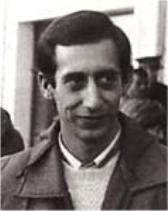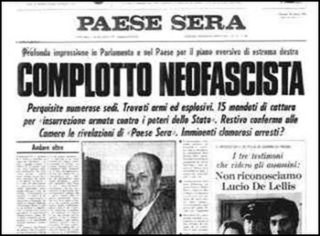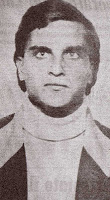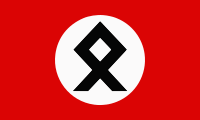Neo-fascism is a post-World War II far-right ideology that includes significant elements of fascism. Neo-fascism usually includes ultranationalism, racial supremacy, populism, authoritarianism, nativism, xenophobia, and anti-immigration sentiment, as well as opposition to liberal democracy, social democracy, parliamentarianism, liberalism, Marxism, neoliberalism, communism, and socialism. As with classical fascism, it proposes a Third Position as an alternative to market capitalism.

Admiral-General Luis Carrero Blanco was a Spanish Navy officer and politician. A long-time confidant and right-hand man of dictator Francisco Franco, Carrero served as Spain's Premier and in various other high ranking offices of the Francoist dictatorship until his assassination in a car bombing in December 1973.
Stuart Christie was a Scottish anarchist writer and publisher. When aged 18, Christie was arrested while carrying explosives to assassinate the Spanish caudillo, General Francisco Franco. He was later alleged to be a member of the Angry Brigade, but was acquitted of related charges. He went on to found the Cienfuegos Press publishing house, as well as radical publications The Free-Winged Eagle and The Hastings Trawler, and in 2006 the online Anarchist Film Channel, which hosts films and documentaries with anarchist and libertarian socialist themes. His memoir Granny Made Me an Anarchist was published in 2004.
The Argentine Anticommunist Alliance was an Argentine Peronist political terrorist group operated by a sector of the Federal Police and the Argentine Armed Forces, linked with the anticommunist lodge Propaganda Due, that killed artists, priests, intellectuals, leftist politicians, students, historians and union members, as well as issuing threats and carrying out extrajudicial killings and forced disappearances during the presidencies of Juan Perón and Isabel Perón between 1973 and 1976. The group was responsible for the disappearance and death of between 700 and 1100 people.
The National Front was a neo-fascist political party in Italy.

Stefano Delle Chiaie was an Italian neo-fascist terrorist. He was the founder of Avanguardia Nazionale, a member of Ordine Nuovo, and founder of Lega nazionalpopolare. He went on to become a wanted man worldwide, suspected of involvement in Italy's strategy of tension, but was acquitted. He was a friend of Licio Gelli, grandmaster of P2 masonic lodge. He was suspected of involvement in South America's Operation Condor, but was acquitted. He was known by his nickname "il caccola" as he was just over five feet tall - although he stated that originally, the nickname came from his very young involvement, at age 14, in the Italian Social Movement (MSI), a neo-fascist political party established after the war
The World Union of National Socialists (WUNS) is an organisation founded in 1962 as an umbrella group for neo-Nazi organisations across the globe.

José Miguel Beñaran Ordeñana was a Basque militant and a key figure in the political evolution of the Basque separatist organization Euskadi ta Askatasuna (ETA). Often known by his nom de guerreArgala (Slim), he took part in the so called Operation Ogre, which consisted in the assassination of Luis Carrero Blanco, Spain's Prime Minister, in 1973. Five years later, he was in turn assassinated by a car bomb in Anglet, French Basque Country by a group directed by far right members inside the Spanish Navy. This group reportedly received assistance from people such as former OAS member Jean Pierre Cherid, former Triple A Argentine member José María Boccardo and Italian neofascist Mario Ricci, member of Avanguardia Nazionale.

The Bologna massacre was a terrorist bombing of the Bologna Centrale railway station in Bologna, Italy, on the morning of 2 August 1980, which killed 85 people and wounded over 200. Several members of the neo-fascist terrorist organization Nuclei Armati Rivoluzionari were sentenced for the bombing, although the group denied involvement.

The Golpe Borghese was a failed Italian coup d'état allegedly planned for the night of 7 or 8 December 1970. It was named after Junio Valerio Borghese, wartime commander of the Decima Flottiglia MAS and a hero in the eyes of many post-War Italian fascists. The coup attempt became publicly known when the left-wing journal Paese Sera ran the headline on the evening of 18 March 1971: Subversive plan against the Republic: far-right plot discovered.
Adriano Tilgher is an Italian far-right politician.
Vincenzo Vinciguerra is an Italian neo-fascist activist, a former member of the Avanguardia Nazionale and Ordine Nuovo. He is currently serving a life-sentence for the murder of three Carabinieri by a car bomb in Peteano in 1972. The investigation in this previously unsolved affair by prosecutor Felice Casson led to the revelation of "Gladio" networks around Western Europe.

CEDADE was a Spanish neo-Nazi group that concerned itself with co-ordinating international activity and publishing.
Aginter Press, also known under the name Central Order and Tradition, was an international anti-communist mercenary organization disguised as a pseudo-press agency and active between 1966 and 1974. Founded in Lisbon, Portugal in September 1966 under António de Oliveira Salazar's Estado Novo, Aginter Press was directed by Captain Yves Guérin-Sérac, who had taken part in the foundation of the OAS in Madrid, a paramilitary group which fought against Algerian insurgents towards the end of the Algerian War (1954–1962). Aginter Press trained its members in covert action techniques, including bombings, silent assassinations, subversion techniques, clandestine communication and infiltration and counter-insurgency.

The Bolivian Socialist Falange is a Bolivian political party established in 1937. It is a far-right party drawing inspiration from fascism. It was the country's second-largest party between approximately 1954 and 1974. After that, its followers have tended to gravitate toward the government-endorsed military candidacy of General Juan Pereda (1978) and, especially, toward the ADN party of former dictator Hugo Banzer.
The Battle of Valle Giulia is the conventional name for a clash between Italian militants and the Italian police in Valle Giulia, Rome, on 1 March 1968. It is still frequently remembered as one of the first violent clashes in Italy's student unrest during the protests of 1968 or "Sessantotto".

In Italy, the phrase Years of Lead may refer to a period of social turmoil, political violence and upheaval that lasted from the late 1960s until the late 1980s, marked by a wave of both far-left and far-right incidents of political terrorism and violent clashes.
The New European Order (NEO) was a neo-fascist, Europe-wide alliance set up in 1951 to promote pan-European nationalism. The NEO, led by René Binet and Gaston-Armand Amaudruz, was a more radical splinter group that broke away from the European Social Movement after denouncing their restrained program.

Franco Anselmi was an Italian neofascist terrorist who was active in the organization Nuclei Armati Rivoluzionari. He was killed during an attempt to rob a gun shop in Rome.
Pierluigi Concutelli, known as The Commander, was an Italian neofascist terrorist and bank robber. He styled himself as an "urban guerrilla fighter". He was a member of the far-right organization Ordine Nuovo, and later became the leader of its underground armed unit, Gruppi di Azione Ordinovista.








